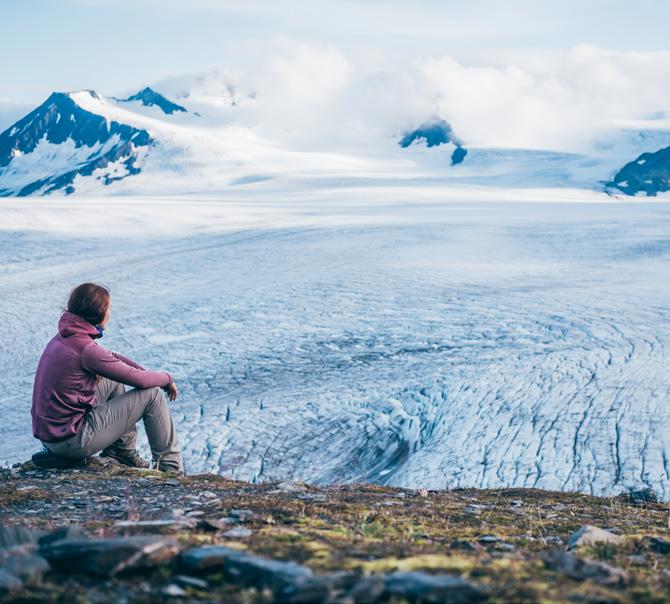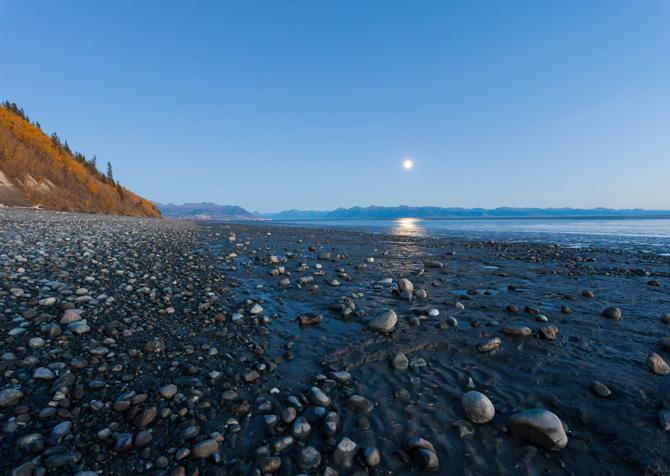
6 minute read
ALASKA’S FINEST CATCH
The Last Frontier’s must-see gems
WORDS BY EMMA CALLEY
Those in search of rugged wilderness will fall in love with Alaska. Dubbed the last frontier, this northern state bordering Canada is positively teeming with natural wonders, from glaciers to mountains and volcanoes. Head north of the Arctic Circle and you’ll find towns rich in Native Alaskan history, with fantastic views of the aurora borealis. Breathe in the crisp, fresh air and take in the sights. Here, 10 of Alaska’s must-see attractions.

Alaska sign
1. The bears of Admiralty Island
A true Alaskan gem, Admiralty Island in the state’s southeast is just a short boat or float plane ride away from capital Juneau. The island itself is a stunning place, with over 90% designated wilderness and plenty of wildlife, but its biggest drawcard is the bear population. It’s believed that this 155km-long island is home to around 1,600 brown bears, more than the other 49 US states combined, outnumbering the human population almost three to one. The best place to spot these grizzly locals is at Pack Creek, congregating during the summer to catch salmon. For animal lovers, Admiralty Island is a must-see.

Pack Creek bear
2. Mendenhall Glacier
Juneau’s most accessible natural attraction is certainly one of its most beautiful. The Mendenhall Glacier flows for 19 kilometres from the Juneau Icefield, down to Mendenhall Lake, providing spectacular views of its ever-changing glacial face along the way. It’s believed that the glacier originated during the Little Ice Age around 3,000 years ago, and has been evolving ever since. Six different trails take people through the Tongass National Forest and up close to the glacier.
Those after a leisurely stroll should start at the visitors centre and walk to one of several viewpoints, while others keen for a more strenuous hike should take the Nugget Falls trail that zigzags near the glacier to the base of – you guessed it – Nugget Falls.

Mendenhall Glacier and Lake in Juneau
3. Denali National Park
Nestled into the foothills of the Alaska Range, Denali National Park is the state’s pride and joy. This vast and immaculate preserve offers much to the adventurous traveller. Drive (or cycle) along the single, winding road and watch as lush forest gives way to snowy tundra and soaring peaks, including Denali (also known as Mount McKinley). Denali National Park sees Africa’s Big Five and raises it with five of its own: moose, caribou, Dall sheep, grizzly bears and wolves all call the park home, so keep your eyes peeled for the locals.

Caribou in Denali National Park
4. Tracy Arm Fjord
Tracy Arm Fjord is a narrow waterway that snakes through Glacier Bay National Park, before ending at the twin Sawyer Glaciers, North and South Sawyer. Listen for calving glaciers and thundering waterfalls as you cruise through the breathtaking inlet, past sheer granite cliffs shaped by years of glacial movement and distant snow-capped mountains. Humpback whales, harbour seals, sea lions and many others frequent the fjord, while bears and goats are common land sightings along the way.

A beautiful waterfall along Tracy Arm Fjord
5. Ship Creek salmon
When people think of salmon, most picture brown bears leaping through water to catch them. In Alaska, this vision is reality. With the arrival of summer, the king or chinook salmon start their journey and by the end of May, millions of fish are fighting against currents and dodging predators with the goal of eventually spawning.
A great place to see this migration is at Ship Creek, in downtown Anchorage. Visit Alaska’s busiest king salmon fishery in late May or June to watch schools of them working their way upstream. For the best action, head to the dam before or after high tide and take a stroll down one of several paths lining the waterway.
6. Harding Icefield
This magnificent 1,813 sq km ice cap in Kenai Fjords National Park is one of the largest in the US and a popular choice for hikers. The icefield and its glaciers are thought to be remnants of the Pleistocene era, when sheets of ice covered much of the state. Today, although much smaller, the Harding Icefield wows visitors with its otherworldly landscape.
Exit Glacier is the most accessible part of the icefield, and the recommended spot for leisure travellers. Those looking for a challenge can tackle the 13 km round-trip Harding Icefield trail, which begins at the Exit Glacier, winding its way up through forests and meadows, before rewarding hikers with panoramic views of the icy expanse, as far as the eye can see.

Harding Icefield
7. Glacier Gardens
While many come to the state for its natural charms, the man-made Glacier Gardens are just as deserving of a spot on any Alaskan bucket list. In this unusual botanic garden, colourful flowers spill from the tops of upside-down trees, creating a spectacular visual against the natural landscape of Tongass National Forest.
Glacier Gardens is the brainchild of Steve and Cindy Bowhay, who designed the space to channel both their creativity and love of nature. Rather than clashing with its surroundings, the garden complements them; the Bowhays used the lay of the land and its natural fauna to guide their horticultural choices. Wander the lower gardens on your own, or enjoy a guided drive through the lush forest, stopping to admire glorious views of Juneau.

Humpback Whales playing in the ocean in Juneau
8. Kincaid Park Sand Dunes
In one of Anchorage’s largest parks, the Kincaid Park Sand Dunes rise from the landscape – remnants from thousands of years ago, when Alaska’s monstrous glaciers retreated. Just like its Arabian desert counterparts, these dunes are active. It’s believed that they’ve been creeping further into the surrounding woods for decades, slowly engulfing trees and anything else in their path. Scramble up the dunes and you’ll see it shifting before your eyes.
If you can make it to the summit of the Kincaid dunes, you’ll be delighted with views of the surrounding forest and beyond, out to the Cook Inlet and Kenai Peninsula.

Moonrise on the beach in Kincaid Park
9. Arctic Kaktovik and its polar bears
Once a sleepy Iñupiat Eskimo village, the city of Kaktovik off the state’s north coast has morphed into the polar bear capital of North America. This icy tundra has a population of just 250 people – mostly Alaskans – but seasonal loss of sea ice brings the bears to land, where they feed on seals and the remains of subsistence whale harvests.
Tour the island by boat with local guides, learning about the spectacular creatures, as well as the local community and life in the Arctic. Polar bears are often found wandering on the barrier islands or chewing on whale bones by the shore, and spotting them is a once-in-a-lifetime experience.

Mother polar bear with its cub during sunset on a sandy ground in Kaktovik
10. Northern lights in Fairbanks
Much of northern Alaska is blessed with views of the aurora borealis, thanks to its latitudinal position, but one of the most accessible spots is Fairbanks. In addition to the usual fixtures of the Alaskan landscape – lakes, mountains and biodiversity – Fairbanks enjoys regular northern lights sightings. Between August and April when conditions are clear, the skies of the central city are illuminated with swathes of green, pink and purple.
Wander to a vantage point, take a guided dog sled tour through the Alaskan wilderness or snuggle up in a heated glass igloo to watch the aurora dance through the glass ceiling; how you sculpt your Fairbanks adventure is up to you.
MAIN IMAGE: Denali National Park







